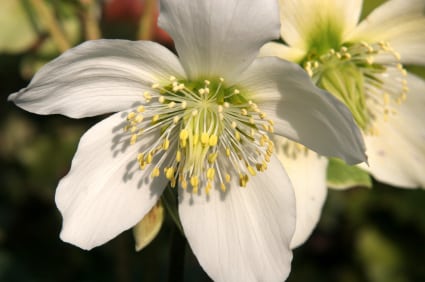Hellebores (Helleborus niger)
 Hellebores, along with Snowdrops and Daffodils, are the in the forefront of flowering plants that seemingly spring up through the last snows of winter. They produce gently nodding flowers that open as early as January and continue to bloom until late April. The plants produce large, saucer-shaped flowers with deeply-lobed, leathery leaves that create an attractive evergreen backdrop to spring bulbs and flowers.
Hellebores, along with Snowdrops and Daffodils, are the in the forefront of flowering plants that seemingly spring up through the last snows of winter. They produce gently nodding flowers that open as early as January and continue to bloom until late April. The plants produce large, saucer-shaped flowers with deeply-lobed, leathery leaves that create an attractive evergreen backdrop to spring bulbs and flowers.
Hellebores are ideal for the front of an early spring border and are used brilliantly to this effect in the Conservatory Garden.
Hellebores are native to southern and central Europe and are found primarily in mountainous areas. However, they can survive in a range of other habitats, from light woodland shade to open alpine meadows. It’s one of Britain’s oldest cultivated plants, believed to have been introduced by the Romans.
Most hellebores grow happily in shade. They appreciate plenty of organic matter in the soil, topped up with mulch every spring (yum). All types of Hellebores prefer a sheltered position away from the effects of strong icy winds in winter and spring that can damage the emerging blooms and leaves.
In the early days of medicine Hellebores were used for anything from gout to use as a purgative. It is also extremely toxic in larger doses (some historians believe that Alexander the Great died because of a hellebore overdose, when he took it as medication.)
Several folk legends surround Hellebores; in witchcraft it is believed to have ties to summoning demons. Helleborus niger is commonly called the Christmas rose, due to an old legend that it sprouted in the snow from the tears of a young girl who had no gift to give the Christ child in Bethlehem. In Greek mythology, Melampus of Pylos used hellebore to save the daughters of the king of Argos from a madness, induced by Dionysus, that caused them to run naked through the city, crying, weeping, and screaming.
Even without such a colorful back story the Hellebores in the Conservatory Garden would still be prized for the lovely manner in which the herald the arrival of spring.
Conservatory Garden
 One of the hidden wonders of Central Park is the Conservatory Garden at Fifth Avenue and 105th St. A secluded oasis, just a few steps down from one of the City’s busiest thoroughfares; the garden offers a fragrant respite from the gasp and clatter of the urban afternoon.
One of the hidden wonders of Central Park is the Conservatory Garden at Fifth Avenue and 105th St. A secluded oasis, just a few steps down from one of the City’s busiest thoroughfares; the garden offers a fragrant respite from the gasp and clatter of the urban afternoon.


